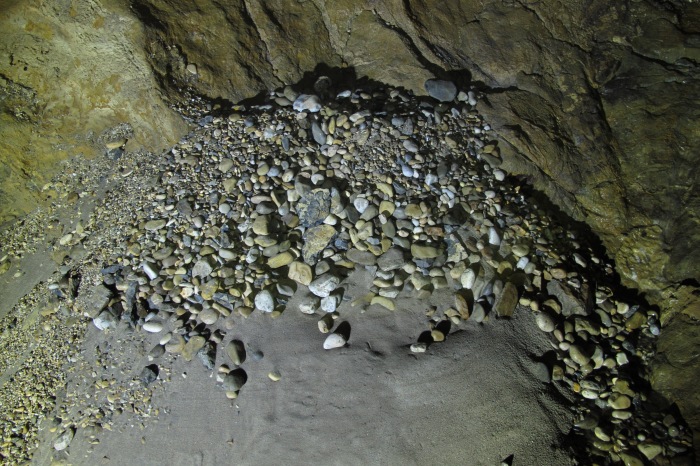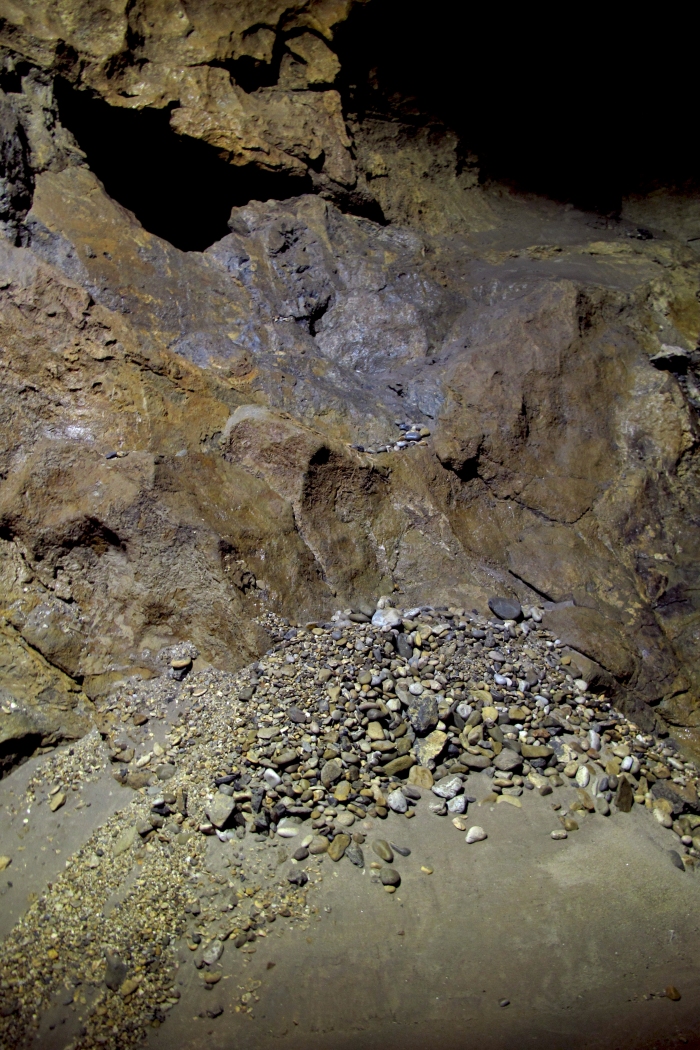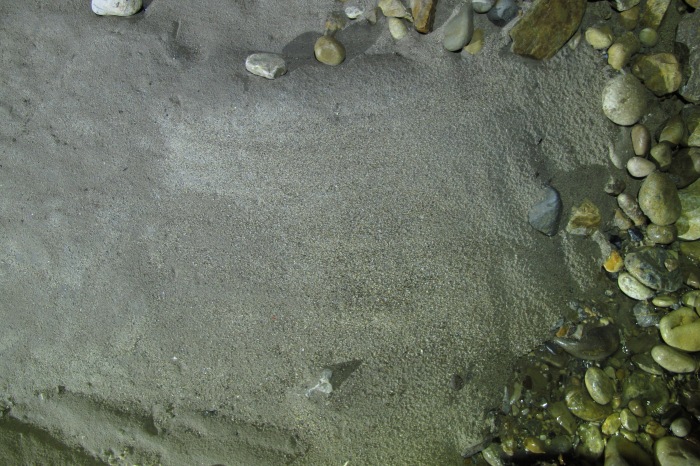English below.

I sassi e la sabbia chiara.
The stones and light sand.
Normalmente il concetto di “sasso” è legato al suo peso:
“Pesante come un sasso”, “Cadere come un sasso”, “I sassi nell’acqua vanno subito a fondo”….Infatti non accade quasi mai che in natura i sassi possano salire, soprattutto su lunghi tratti aventi forti dislivelli.
Eppure nella Grotta del Vento ciò è accaduto, le prove sono inconfutabili e documentate fotograficamente.
Fin dall’inizio dei lavori di valorizzazione turistica si era ipotizzato un collegamento idrico tra il sifone iniziale, che i turisti superano mediante una breve galleria artificiale, e la zona del Fiume Acheronte, situata nella parte più profonda del “secondo itinerario”, ricca di ciottoli arrotondati e levigati e di sabbia chiara. Ma questo collegamento non era visibile e, pensando che fosse sepolto dai detriti, sul finire degli anni 80 venne fatto uno scavo sul fondo del sifone iniziale, ma non fu trovato alcun passaggio. Si notò però che in una parete c’era un foro di circa 60 centimetri di diametro, che venne subito esplorato per una lunghezza di una quindicina di metri, fino a un punto in cui il cunicolo, strettissimo, scompariva nell’acqua e nel fango, divenendo impraticabile.

Il mucchio dei ciottoli e, in alto a sinistra, il foro dal quale sono usciti.
The pile of stones and, top left, the hole from where they came out from.
Le ricerche furono pertanto abbandonate, ma il 20 ottobre 2013 avvenne qualcosa di inatteso che confermò l’ipotesi del collegamento. Durante la notte un violentissimo nubifragio fece salire di 60 metri il livello dell’Acheronte, fino a farlo traboccare nel 1° itinerario, provocando dall’ingresso della grotta una fuoruscita d’ acqua della portata 6 metri cubi al secondo.
Qualche settimana più tardi, sul fondo del sifone iniziale ormai prosciugatosi, si notò sotto il foro in parete precedentemente esplorato un mucchio molto eterogeneo di ciottoli arrotondati, misti a sabbia chiara. Sia i sassi, alcuni dei quali pesavano più di mezzo chilo, sia la sabbia, erano identici a quelli che costituiscono il letto dell’Acheronte. Sassi e sabbia di quel tipo non erano mai stati visti un nessun altro punto della Grotta.

La sabbia chiara. The light sand.
Per sollevare quei ciottoli di 30 metri (tale è il dislivello che separa l’Acheronte dal sifone iniziale) la corrente d’acqua doveva essere violentissima. Per avere quella velocità si ipotizza che il condotto sia particolarmente stretto e uniforme, forse impraticabile dall’uomo, e soprattutto privo di espansioni che, rallentando la corrente, avrebbero provocando la decantazione del materiale solido.
STONES THAT RISE UP
Normally the concept of “stone” is associated with its weight, …“heavy as a rock”, “drop like a stone”, “stones in water go straight to the bottom”…. And in fact it almost never happens in nature that stones can rise up, especially over long tracts with big differences in height.
And yet in the Grotta del Vento it has happened, the proof is undeniable and documented with photographs.
Right from the start of the work to open the cave to the public there was the hypothesis of a water connection between the initial siphon, which tourists pass by means of a short man-made tunnel, and the area of the Acheronte River, situated in the deepest part of the “second itinerary”, where there are many smooth round pebbles and light sand. But this connection was not visible and, thinking that it was buried by detritus, around the end of the 80’s an excavation was made on the bottom of the initial siphon, but no passage was found. However it was noticed that on one wall there was a hole of about 60 centimetres in diametre, which was immediately explored for a length of about fifteen metres, until a point where the extremely narrow tunnel disappeared into the water and mud.
The search was therefore abandoned, but on the 20th October 2013 something unexpected happened which confirmed the hypothesis of a connection. During the night a violent storm caused the Acheronte river to rise up 60 metres in level, making it overflow into the 1st itinerary, causing water to flow out of the entrance with a capacity of 6 cubic metres per second.
A few weeks later, at the bottom of the initial siphon, by that time dried up, it was noticed under the hole in the wall which had previously been explored a very diverse pile of rounded stones, mixed with light sand. Both the stones, some of which weighed more than half a kilo, and the sand, were identical to those which make up the river bed of the Acheronte. Stones and sand of that type had never been seen in any other part of the Cave.
To have raised those stones up 30 metres (that is the difference in level which separates the Acheronte from the initial siphon) the water current must have been extremely violent. To have that speed it has been hypothesized that the conduit must be particularly narrow and smooth, maybe impracticable for man, and above all without any expansion which, slowing down the current, would have provoked the decantation of solid matter.

Un’immagine ravvicinata dei ciottoli.
A close image of the stones.

